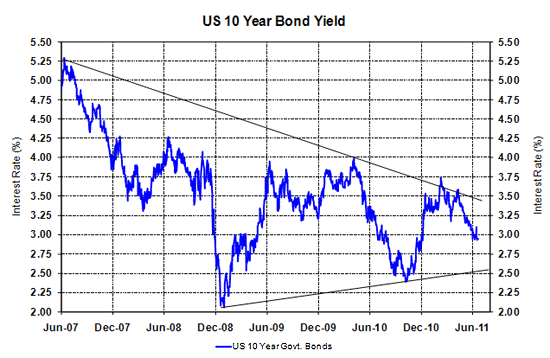
 By Roger J Kerr
By Roger J Kerr
The moneymarkets continue to price future NZ interest rate levels well below what the RBNZ project in their latest monetary policy statement and well below what I believe will be actual interest rate outcomes based on the GDP growth and related inflation outlook.
The current shape of the swaps yield curve has the market pricing of 90-day rates to be 3.50% in June 2012 2112 and 4.25% in June 2013 2012.
It is a nice thought for home mortgage borrowers that interest rates will stay that low for that long, however with annual inflation at a 3.00% run rate during 2012/2013, the current price of term money looks far too cheap, and thus not sustainable.
There are several possible explanations as to why the interest rate markets continue to price term swap yields lower than what appears to be half reasonable:
- Repeating Christchurch earthquakes are pushing market interest rates down when they occur, however the economic data that has come out over recent weeks suggests that the negative impact on the wider economy from the earthquakes is actually less than what most thought.
- Global investors are currently taking risk off the table with sharemarkets and commodity prices down. There has been some flight to quality into US Treasury Bonds as European debt issues and tightening of monetary policy in emerging markets makes investors re-think about risk and return. The buying of US bonds has forced their yields and our longer-dated swap rates lower. At some point, US bond supply, GDP growth and inflation risks in the US will force US 10-year Treasury bond yields back up from below 3.00% (see chart below).
- Earthquake reinsurance funds sitting around on deposit with the banks waiting for claims settlements is temporarily and artificially holding market interest rates lower than what they would normally be at.
- Despite business and consumer confidence improving over recent months, most households with mortgages are staying at the cheaper floating rate for the meantime, thus no swap market paying demand on the banks from mortgage interest rate fixing. It might take the first OCR increase from Alan Bollard in December to change this thinking, by which time swap and fixed rate mortgage rates will be 0.50% higher than where they are now.
Bank economists who confidently forecast a 0.5% contraction in the economy in the March quarter a few months back are now hastily revising their forecasts to +0.3% for the quarter now that export/import, retail and manufacturing data has all confirmed the economy was travelling quite well through the earlier part of the year.
Interest rate risks are extenuated right now due to the above factors causing market rates to be artificially and unsustainably low.
It won’t last!
US 10-year Treasury Bond yields are currently slap bang in the middle (at 2.95%) of the converging wedge formation of the downtrend and uptrend lines on the chart below.
My gut tells me they will be challenging a break-out to the top-side at 3.50%, rather than breaking below the 2.50% bottom.

--------------------
* Roger J Kerr runs Asia Pacific Risk Management. He specialises in fixed interest securities and is a commentator on economics and markets. This column was written before the Monday quake. More commentary and useful information on fixed interest investing can be found at rogeradvice.com
No chart with that title exists.

We welcome your comments below. If you are not already registered, please register to comment
Remember we welcome robust, respectful and insightful debate. We don't welcome abusive or defamatory comments and will de-register those repeatedly making such comments. Our current comment policy is here.